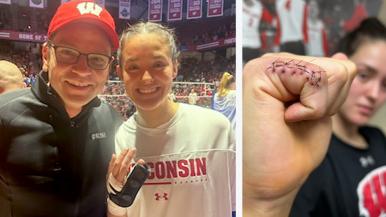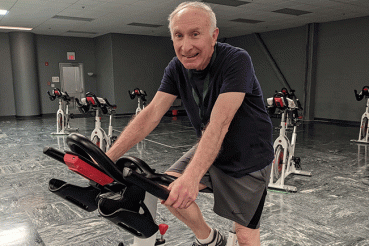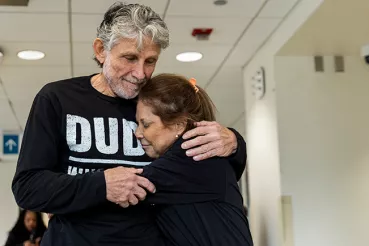As soon as the volleyball hit her pinkie finger after a hard spike from an opposing player, Caroline Crawford knew it was broken.
“I could tell immediately from how it looked and how it felt,” she says.
Even worse, she feared it would keep her from helping her team, the University of Wisconsin Badgers, vie for the Big Ten conference championship in a few weeks.
An X-ray taken by the team physician confirmed the break. What was left to be decided was whether she would need surgery, and how long her recovery would take. The X-ray was sent to Jonathan Tueting, MD, a hand and upper extremity surgeon with Rush Orthopaedics & Sports Medicine and former associate team physician for the Badgers.
“The X-ray clearly showed a proximal phalanx fracture, in six pieces. Since the finger was twisted and displaced, non-surgical management was not the right choice,” Tueting says.
He determined there were two surgical options: a procedure in which a plate and screws were inserted, and another that used pins only. Because of the complexity of the fracture, and Caroline’s goal of returning to action, Tueting decided on the first, more stable, option.
“We were pushing the envelope, so I had to think critically about how to stabilize the fracture and return her range of motion — and I had to think creatively about how to protect her while playing.”
The surgery was a success, with no complications. Incredibly, Caroline chose not to be put under with a general anesthesia, only receiving an ulnar wrist block for pain control. She even watched several finger surgeries on YouTube beforehand to prepare herself.
“I’m in pre-med, so I thought it would be a cool experience,” she explains. “Not a lot of people experience sitting in on their own surgeries.” According to Tueting, she was a little anxious but “super curious” during the procedure.
The next crucial step was Caroline’s recovery process, which she followed diligently and Tueting monitored closely. “Elevation, icing, anti-inflammatories, daily exercise, no contact for two weeks,” Tueting says.
Once her pain was under control and her range of motion was coming back, she was fitted for a hand splint and began basic movement drills for setting, passing and serving. She eased back into practice, and then, just a few weeks after her surgery…game time.
“She was tenacious, no quit,” says Tueting, who attended Caroline’s first game back — the game against Nebraska that UW won to claim the conference championship.
Tueting often takes in games of his recent patients, finding it rewarding to take care of athletes who are highly motivated to get back to the sport they love. It’s something he relates to not only as a former high-level athlete himself, but as a surgeon who treats patients from every walk of life.
“I always ask my patients what activities give meaning to their lives, what hobbies give them joy. Whether it’s baking or just playing with their kids, everybody uses their hands, elbows and shoulders, so it’s important to me to know that part of who a patient is — what makes them tick. It helps build a bond of trust and faith to know who they are.”
Caroline experienced Tueting’s skill and compassion firsthand. “I wouldn’t have been able to play the rest of the season without his knowledge and expertise. And he cared enough to check in on my progress along the way with both me and our athletic trainer. The whole experience really solidified my goal of helping people — and making a difference — by becoming a doctor.”




